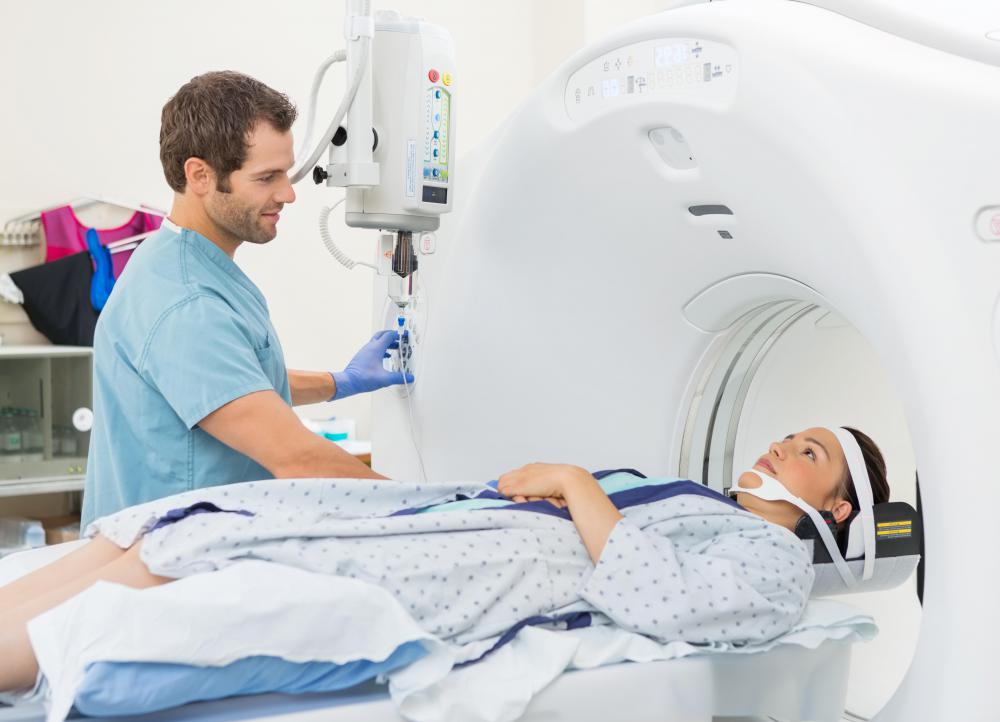At TheHealthBoard, we're committed to delivering accurate, trustworthy information. Our expert-authored content is rigorously fact-checked and sourced from credible authorities. Discover how we uphold the highest standards in providing you with reliable knowledge.
What is an MRI with Contrast?
MRI stands for magnetic resonance imaging; it basically uses powerful magnets and radio waves to create detailed images of the interior of your body. It can be done with or without contrast. Contrast is a type of dye that is injected intravenously either right before, or during the procedure. Certain abnormalities, such as tumors, will absorb the dye and show up very clearly on the MRI with contrast. Your doctor will determine whether you need an MRI with contrast or without, and may order both tests.
An MRI scan is different than a regular x-ray or a CT scan, which both use ionizing radiation to create images. MRI scans generally produce clearer images with much more detail than an x-ray or CT scan. Small tumors, which may be invisible on an x-ray or CT scan, may be detected by MRI. In the case of most cancers, the earlier treatment is begun, the better the outcome of treatment, so an early MRI scan of any suspicious area can literally mean the difference between life and death.

As good as a standard MRI image is, the image can be improved even further by adding contrast. Tumors and other abnormalities will absorb the contrast dye as it progresses through your blood vessels, and on the MRI scan this area will glow. This allows for the detection of even the smallest tumors, and it also gives your doctor a clearer idea about the location and size of a tumor and which organs or tissues are involved. In addition, contrast allows a doctor to observe functional abnormalities that are not visible on a regular scan, particularly problems with how well your blood is flowing through your vessels.

The contrast medium used in MRI, generally gadolinium, is different than the contrast dyes used in x-rays or CT scans. Adverse reactions to gadolinium are much rarer than iodine-based dyes. However, if you have abnormal kidney function, you may be at increased risk for nephrogenic systemic fibrosis caused by the MRI dye. This complication is extremely rare, but always be sure your doctor and radiology technician are aware of any medical problems or allergies you may have, before you are injected with any type of contrast dye. Most people tolerate MRI with contrast just fine, and the benefits of early tumor detection generally outweigh the minor risks associated with the dye.

An MRI with contrast is generally painless, but you may experience some discomfort with the IV or needle used to inject the dye. You will be placed on a table and positioned so that the scan will show the affected area most clearly. You may be slid inside a long narrow tube in a closed MRI, or you may have an open MRI, in which the scanning equipment is shaped like a large doughnut and only scans a certain portion of your body at a time. The imaging process itself may take 45 minutes up to two hours, and you may be offered headphones so you can listen to music during the scan. Once the scanning is complete, a radiologist will read and interpret the scan and your doctor will discuss the results with you.
AS FEATURED ON:
AS FEATURED ON:
















Discussion Comments
An MRI with contrast isn't a big deal. Get an IV, go in machine. Meds feel cool when being administered. Was just in for about an hour last week. Hardest part was not falling asleep so I could inhale and exhale on command. But maybe the crew at Charlottesville, VA are just a great group to be with, they are so very kind.
I have just had an MRI with contrast to view heart problems, functionality and blood flow problems. I hated it. I do not wish to scare anyone, but for me personally, it was an unpleasant experience. I first had to come out of the contraption as felt very claustrophobic. I re-entered and never opened my eyes once for fear of the surroundings. The contrast dye added was awful. It needed doing but I would not wish to repeat the process.
MRI is a vital diagnostic tool. I was glad that my MRI ruled out a tumor. I just wish it wasn't so loud. Even with headphones, I could not help but hear the jackhammer noise pounding in my ears. For someone with severe headaches, the experience was very unpleasant.
I had an MRI with contrast and was glad it was done this way. Why go through the procedure twice? I did have areas that lit up white. The MRI was yesterday and I am awaiting the results.
what can the results of mri with contrast be when you have a chirping in the ear which leads to a screeching should which affects balance?
Some people have trouble with MRI tests in general, not because they are painful but because of the noise and lights involved. I once had an MRI without contrast, and while it was fine for me, it was not something I would have liked to repeat with contrast.
In my experience, a contrast MRI might be performed only after other tests, including an MRI without contrast, have been done with little or no results. Performing an MRI scan with contrast can be a complicated procedure, and many doctors try not to put their patients through such tests unless they are truly necessary.
Post your comments